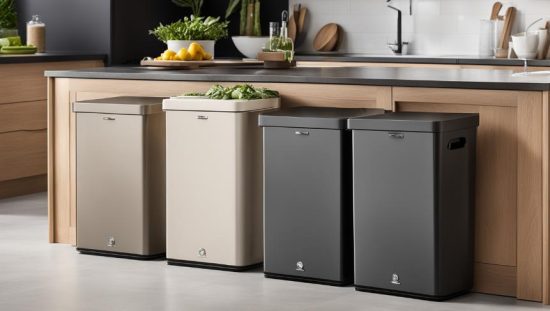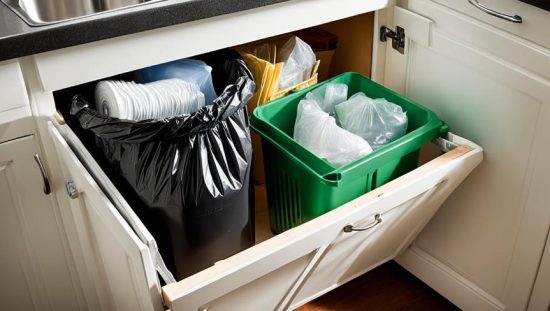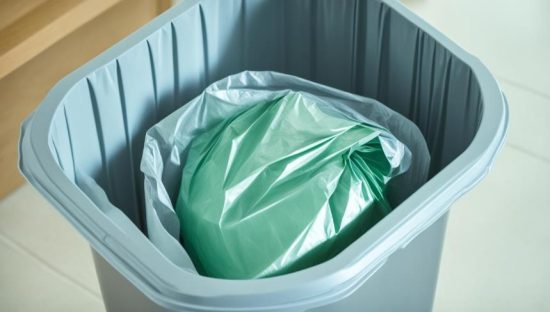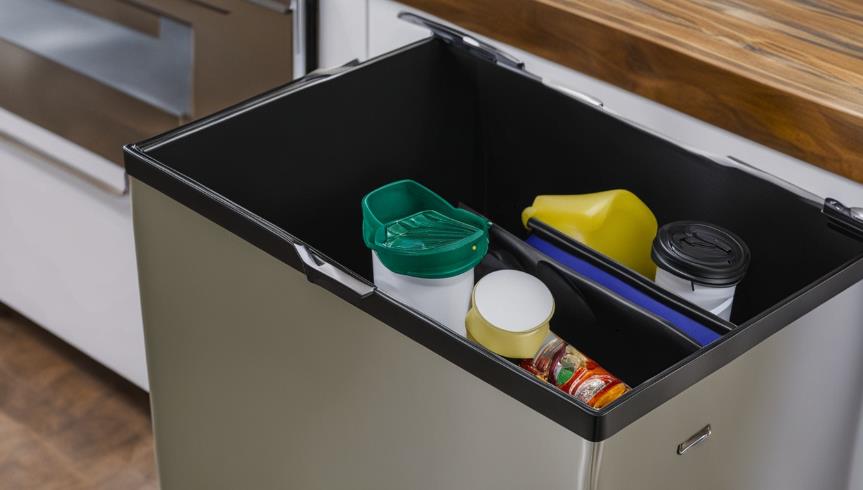When it comes to selecting a kitchen trash can, one crucial question arises: how many gallons is the right size? We often underestimate the importance of the size of our trash cans, but it can significantly impact the efficiency and cleanliness of our kitchens. Have you ever wondered if your trash can is too big or too small for your needs?
In this full guide, we will explore how many gallons is a kitchen trash can and the various factors that affect the size of a kitchen trash can. From trash can measurements to gallon capacity, we will delve into the details that will help you select the perfect trash can for your kitchen.
The Importance of Selecting the Right Size Trash Can

Selecting the right size trash can is crucial for efficient space management and effective waste disposal. When it comes to finding the ideal trash can size, considerations for both space and cleanliness are important.
Considerations for Space and Cleanliness
One of the primary considerations when choosing a trash can size is the available space in your kitchen. A trash can that is too large can take up valuable floor space, making it difficult to move around and potentially cluttering your kitchen. On the other hand, a small trash can may not provide enough capacity to hold all the waste generated, leading to frequent emptying and potential mess.
Additionally, the size of the trash can can impact cleanliness. If you select a large trash can but do not produce enough waste to fill it regularly, it may result in unnecessary waste buildup and odors. On the contrary, if you choose a small trash can that fills up quickly, you may experience overflow and spills, making it challenging to maintain a clean and tidy kitchen environment.
Goldilocks Principle: Not Too Big, Not Too Small
When it comes to choosing the right size trash can, it’s all about finding a balance. The Goldilocks principle applies – you want a trash can that is “just right” for your needs. Opting for a trash can that is neither too big nor too small ensures that you have sufficient capacity to accommodate your waste without cluttering your kitchen or creating unnecessary mess.
By selecting the ideal trash can size, you can optimize your kitchen space, maintain cleanliness, and effectively manage your waste. Whether you are looking for a space-saving trash can or considering the right size for your specific needs, finding the perfect fit will enhance your overall waste management experience.
Understanding Trash Can Measurements
When it comes to selecting the right trash can for your kitchen, understanding the measurements is crucial. Trash can measurements encompass both dimensions and volume, which are essential factors in determining if a trash can will fit your space and meet your waste management needs.
Average Dimensions of Kitchen Trash Cans
The average dimensions of kitchen trash cans can vary depending on their shape and style. However, they generally fall within a certain range to accommodate the needs of most households. When considering a trash can, it’s important to pay attention to its height, width, and depth to ensure it fits well in your kitchen and allows for easy disposal.
From Gallons to Cubic Inches: Making Sense of Volume
Trash can volume is often measured in gallons, representing the amount of waste the can can hold. However, understanding the conversion from gallons to cubic inches can provide a clearer understanding of the available space inside the trash can. This knowledge helps you gauge the capacity of the trash can and determine if it aligns with your waste disposal needs.
Types of Kitchen Trash Cans and Their Capacities
When it comes to selecting the right trash can for your kitchen, it’s essential to consider the type and capacity that best suits your needs. Kitchen trash cans come in various types, each offering unique features and functionalities.
Freestanding Versus Built-in Trash Receptacles
Freestanding trash cans are versatile options that can be placed anywhere in your kitchen. They come in different sizes and styles to complement your kitchen decor. Whether you need a smaller can for daily waste or a larger can for a busy kitchen, freestanding trash cans provide a range of capacities to meet your requirements. These trash cans can hold various amounts of waste, from smaller 8-gallon options to larger 20-gallon capacities.
If you’re looking to optimize space and create a seamless look in your kitchen, built-in trash receptacles are an excellent choice. These cans are integrated into your kitchen cabinetry or under the sink, providing a discreet and space-saving solution. Although they are typically smaller in size, built-in trash cans can still accommodate a sufficient amount of waste. You can find built-in options with capacities ranging from 5 to 15 gallons, allowing you to select the size that best fits your needs.
Specialized Containers for Recycling
Promoting sustainability and proper waste management in your kitchen is made easier with specialized containers for recycling. These containers are designed specifically for separating recyclables from regular trash, enabling you to contribute to a greener environment. Recycling bins come in various sizes and can be freestanding, built-in, or countertop options.
By incorporating these specialized containers into your kitchen, you can efficiently segregate recyclables like plastic, glass, and paper, making it easier for proper recycling collection and processing.
When choosing your kitchen trash can, consider the type that suits your needs – whether it’s a freestanding or built-in option – and the capacity that can handle the amount of waste you generate on a daily basis. Additionally, incorporating recycling containers ensures that you’re playing your part in reducing environmental impact and promoting sustainable waste management practices.
The Impact of Household Size on Trash Can Volume
The size of your household can have a significant impact on the volume of trash you generate. A larger household with more members will typically produce more waste and require a larger trash can to accommodate it. Conversely, a smaller household may not generate as much waste and can opt for a smaller trash can. It is important to consider your household size when selecting the appropriate trash can volume to ensure it can adequately handle your waste needs.
As the number of individuals in your household increases, so does the amount of waste generated on a daily basis. This waste can include food scraps, packaging, and other household items. By choosing a trash can with a larger capacity, you can efficiently handle the waste produced by your household without frequent emptying. This saves you time and effort in managing your trash.
On the other hand, if you have a smaller household, such as a single person or a couple, you may not generate as much waste. In this case, a smaller trash can may be more suitable, as it takes up less space and requires less frequent emptying. This can be particularly beneficial if you have limited kitchen space.
When considering the trash can volume for your household, it is important to strike a balance between capacity and practicality. You want a trash can that is large enough to accommodate your waste needs but not so big that it becomes a hindrance or takes up unnecessary space in your kitchen.
Optimizing Your Kitchen Space with the Correct Trash Can Size
When it comes to maximizing efficiency in your kitchen, optimizing the use of space is crucial. This includes carefully considering the layout and available floor space to ensure every inch is utilized effectively. One area where you can make a significant difference in optimizing kitchen space is by selecting the correct trash can size.
A well-fitting trash can that seamlessly integrates into your kitchen’s layout can make waste disposal more convenient and efficient. Instead of occupying precious floor space, you can choose a space-saving option that allows for efficient use of the area while still accommodating your waste disposal needs.
One popular space-saving option is an under-sink trash can. By utilizing the often-unused space beneath your sink, you can create a discreet and efficient waste management solution. The under-sink trash can provides a clever way to keep your kitchen space organized and clutter-free. It is especially beneficial for kitchens with limited floor space, as it allows you to make the most of every available inch.
How Many Gallons Is a Kitchen Trash Can?-Choosing the Right Trash Bag Size for Your Can
Kitchen trash cans typically hold 12 to 16 gallons (45 to 60 liters), and the most popular size is 13 gallons for trash bags. For families of four or fewer, this size is perfect; but, if you have a larger gathering or a commercial kitchen, you might want to consider upgrading to a 20-gallon+ (75-liter+) unit.
When it comes to managing your kitchen waste, choosing the right trash bag size is essential for avoiding wastage and spillage. An improperly sized bag can lead to unused space or overflowing garbage, creating unnecessary mess and inconvenience.
One of the key factors in determining the appropriate trash bag size is understanding the capacity of your kitchen trash can. Different trash cans have varying gallon sizes, which indicate the amount of waste they can hold.

Navigating Liners: Avoiding Wastage and Spillage
Using a trash bag that is too large for your trash can can result in wastage of plastic and space. When an oversized bag is used, you may end up using more plastic than necessary, contributing to environmental concerns. Additionally, an excess bag may not fit snugly around the rim of the trash can, leaving unused space that could have been utilized for additional waste.
On the other hand, using an undersized bag can lead to spillage and mess. When the bag is not large enough to fully cover the trash can, the excess waste may overflow, causing a potential cleanup nightmare.
To avoid both wastage and spillage, it’s important to select a trash bag size that fits your kitchen trash can properly. Opt for a bag that matches the gallon capacity of your trash can or is slightly larger, ensuring a secure and complete containment of waste.
Cost-Efficiency with Bag Compatibility
Aside from avoiding wastage and spillage, considering cost-efficiency is also crucial in managing your kitchen waste. By choosing the right trash bag size, you can optimize your waste management process and save money.
Smaller trash bags are generally more cost-effective, as they require less material for production. However, keep in mind that using an undersized bag may lead to more frequent bag changes, potentially offsetting any savings. It’s important to strike a balance between bag size and frequency of replacements.
Additionally, exploring compatible bag options can further enhance cost-efficiency. Some trash can brands offer specially designed bags that perfectly fit their respective trash cans, eliminating the risk of using improper sizes. These bags are often tailored to the dimensions and shape of the specific trash can, ensuring a secure fit and minimizing the chance of wastage and spillage.
Materials Matter: Plastic vs. Stainless Steel Trash Cans
The choice of material for your trash can can have a significant impact on its durability, aesthetics, and functionality. When it comes to kitchen trash cans, two common materials are plastic and stainless steel. Each material has its own set of advantages and disadvantages that you should consider when making your decision.
Advantages and Disadvantages of Different Materials
Plastic trash cans are generally more affordable and lighter in weight compared to stainless steel trash cans. They are also available in a wide range of colors and designs, making it easier to find one that matches your kitchen decor. However, plastic trash cans may be less durable and more prone to cracking or breaking over time. They can also absorb odors, leading to unpleasant smells in your kitchen.
On the other hand, stainless steel trash cans offer a sleek and modern look that can complement various kitchen styles. They are often more durable and resistant to damage, making them a long-lasting investment. Stainless steel trash cans are also easier to clean and maintain, as they are less likely to absorb odors. However, they can be more expensive than their plastic counterparts.
Maintaining a Clean and Tidy Kitchen with the Ideal Trash Can

The ideal trash can plays a crucial role in keeping your kitchen clean and tidy. With proper waste management and disposal, you can prevent unpleasant odors, keep pests at bay, and eliminate unnecessary mess. To maintain cleanliness in your kitchen, consider the following tips:
1. Choose the right size trash can: Select a trash can that suits your needs. A size that is too small may result in overflow and mess, while a size that is too big may take up unnecessary space. Find the ideal balance that accommodates your waste volume.
2. Use appropriate liners: Utilize liners that are specifically designed for your trash can size. This ensures a snug fit and prevents spillage or wastage. By choosing the right liner, you can contain your waste effectively and avoid any potential mess.
3. Regularly empty and clean the can: Emptying your trash can regularly is essential to prevent odors and maintain hygiene. Additionally, regularly cleaning the can itself helps eliminate any residual dirt or odor. Consider using mild cleaning agents and disinfectants to keep your trash can fresh and sanitary.
FAQs
What are the common sizes for kitchen trash cans in gallons?
Kitchen trash cans typically come in sizes ranging from 5 to 20+ gallons, with 10-13 gallons being the most common for household use.
How do I determine the right size of kitchen trash can for my household?
The right size depends on household size, trash disposal frequency, and available kitchen space, with 10-13 gallons suitable for most families.
Are there specific brands known for durable kitchen trash cans in various gallon sizes?
Brands like Simplehuman, Rubbermaid, and Glad are known for their durable and high-quality kitchen trash cans, available in multiple sizes.

